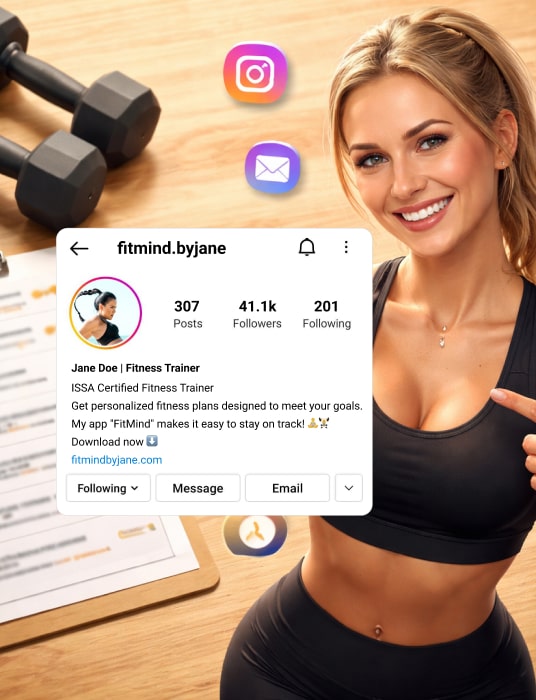Are You Earning Up to Your Potential?
Most personal trainers are undervaluing their time and skills. Our Personal trainer Revenue Calculator helps you find out what you should be making, and how to get there.
No guesswork. Just real numbers.
.jpg)
The fitness industry is more dynamic than ever, with exciting opportunities emerging for aspiring entrepreneurs, trainers, and wellness professionals. From digital coaching to mobile training units, today's market offers a wide range of fitness business ideas that cater to different lifestyles, demographics, and fitness goals.
If you're exploring how to start a fitness business in 2025, this guide covers seven innovative, profitable fitness business models you can launch, with real potential for growth. Whether you're passionate about group fitness classes, online coaching, or launching your fitness brand, now is the time to tap into this $100+ billion global market.
Let's dive into these fantastic fitness business ideas to inspire your fitness entrepreneurial journey.
1. Online Personal Training & Coaching

This is one of the most profitable fitness businesses to launch with minimal overhead and global reach. As more people turn to digital solutions for health, now is the perfect time to tap into the growing online fitness market.
Why it works: The rise of remote work and digital lifestyles has led to a booming demand for online fitness business ideas. In 2025, virtual personal training is no longer an alternative—it's the norm for many clients seeking tailored fitness programs on their schedules.
What it is: As an online fitness coach, you deliver customized fitness programs, workout routines, nutrition plans, and accountability via apps, video calls, and online courses. You can scale your impact while keeping overhead costs low.
How to start:
- Get a recognized personal training certification
- Build a strong presence on social media platforms
- Use fitness apps or custom fitness app development tools to manage programs
- Offer virtual fitness classes, 1:1 sessions, or online fitness courses
Revenue potential: Highly scalable—charge $100 to $500+ per client/month.
Best for: Fitness professionals, nutritionists, and fitness influencers looking to expand their reach.
2. Mobile Personal Training Business
This is a low investment fitness business that meets clients where they are—literally. With the rising demand for flexible, on-the-go fitness services, mobile training provides a highly personalized experience that eliminates the need for a physical gym.
Why it works: Convenience is king in 2025. Clients love the idea of a mobile personal training business that brings fitness equipment and fitness services to their homes, offices, or parks.
What it is: You provide personal training or group classes at the client's location using portable gear, bodyweight exercises, or minimal setups. Think of it as Uber, but for personal training.
How to start:
- Invest in mobile-friendly fitness equipment
- Offer specialized services like strength training, senior fitness programs, or yoga classes
- Market to corporate clients, busy parents, or elderly communities
- Use scheduling apps and GPS tools to manage sessions
Revenue potential: $75–$150/hour, depending on location and niche.
Best for: Trainers who love flexibility and want a low-investment fitness business.
3. Boutique Fitness Studio with Specialized Programs
If you're looking for unique fitness business models that combine passion, community, and profit, this is a fantastic option. Boutique studios thrive in 2025 by offering specialized fitness programs that deliver a premium, personalized experience to a loyal client base.
Why it works: The popularity of boutique fitness studios continues to grow as people seek personalized, community-driven fitness experiences. These studios specialize in specific niches, such as dance fitness classes, strength training, yoga, or virtual fitness challenges.
What it is: A compact fitness studio offering niche group fitness classes. These could include:
- HIIT or boot camps
- Dance fitness classes
- Prenatal or senior fitness programs
- Functional or sport-specific training
How to start:
- Choose a niche aligned with your passion and market demand
- Design your fitness business plan with clear branding and pricing
- Consider hybrid offerings like in-person + virtual fitness classes
- Use effective marketing strategies to attract local fitness enthusiasts
Revenue potential: Studios typically earn $10,000–$50,000/month, depending on size and member base.
Best for: Entrepreneurs with a strong niche idea looking to build a community-driven fitness business.
💪 Got an idea for a brand? Let's bring it to life.
Launch your own fitness app with FitBudd in minutes!

💪 Got your brand name? Let’s bring it to life.
Launch your own fitness app with FitBudd in minutes!


88% trainers worldwide gave us 5 stars
Transform your fitness business with the power of your branded app on iOS and Android.
Try for FREE4. Fitness Retreats & Wellness Travel
This is one of the most innovative fitness business ideas for 2025, blending the booming travel industry with the rising demand for mental health and physical well-being. It's a perfect fit for fitness entrepreneurs who want to offer immersive, high-impact experiences beyond the gym.
Why it works: Travelers today want more than sightseeing—they crave transformational experiences that improve physical fitness and mental well-being. Fitness retreats cater to this trend by combining travel, workouts, clean eating, and mental health workshops.
What it is: A destination-based wellness business idea offering multi-day programs focused on fitness, nutrition, and mindfulness. Think yoga in Bali, strength bootcamps in Arizona, or surfing + fitness in Portugal.
How to start:
- Choose your location and target audience (e.g., women's retreats, corporate getaways)
- Create specialized fitness programs combining fitness classes, nutrition, and relaxation
- Partner with hotels, chefs, and local tour guides
- Promote through fitness influencers and social media platforms
Revenue potential: Retreats can earn $2,000 to $5,000 per attendee.
Best for: Fitness entrepreneurs with travel experience and a passion for wellness.
5. Fitness E-Commerce & Digital Products

This is a profitable fitness business model that runs 24/7 and scales effortlessly. By combining content creation with fitness app development or online courses, you can generate passive income while supporting your audience's fitness goals worldwide.
Why it works: As more people pursue online fitness, they're investing in products that support their fitness journey—from digital downloads to fitness equipment to branded gear.
What it is: Sell physical or digital products via your fitness e-commerce store. Examples include:
- Branded fitness equipment or accessories
- Online courses on fitness, nutrition, or wellness
- Ebooks, guides, and meal plans
- Fitness apps or subscription-based digital programs
How to start:
- Use platforms like Shopify, Kajabi, or Gumroad
- Develop high-quality digital content
- Partner with manufacturers or dropshippers
- Use email marketing and SEO to attract clients
Revenue potential: Digital products have high profit margins, with $ 10,000+/month possible with substantial traffic.
Best for: Creators and coaches looking to monetize content at scale.
6. Corporate Wellness Programs
This is one of the most strategic fitness business ideas for 2025, tapping into the growing demand for employee health and workplace well-being. It allows fitness professionals to work with corporate clients at scale, delivering meaningful impact and consistent revenue.
Why it works: Companies are investing more in employee health to boost productivity and reduce burnout. Offering corporate wellness programs is a smart way to build a profitable fitness business while impacting hundreds of lives.
What it is: Deliver fitness services, virtual fitness challenges, and workshops tailored to office environments. This can include:
- Virtual fitness classes via Zoom
- On-site group workouts or personal training
- Mental wellness and fitness tips sessions
- Custom online coaching portals for employees
How to start:
- Package your services with pricing tiers (remote, hybrid, in-person)
- Use surveys to design tailored fitness programs
- Pitch to HR teams and offer pilot programs
- Track results (engagement, attendance) to demonstrate ROI
Revenue potential: B2B contracts can range from $10K to $ 100 K+ annually.
Best for: Trainers with experience in online coaching or group facilitation.
7. Virtual Fitness Studio or App-Based Coaching
If you're looking for innovative fitness businesses with high scalability, this is a top contender. With the right tech and content, you can build a successful fitness business that reaches thousands of users across the globe—without a physical location.
Why it works: The success of platforms like Peloton, Centr, and FitOn shows that virtual fitness business models are here to stay. With today's tech, you can launch your virtual fitness studio or subscription-based fitness app.
What it is: Build an online fitness business offering live or on-demand fitness classes, fitness challenges, or coaching via a mobile app or web portal. Focus on a niche—HIIT, meditation, yoga classes, or online fitness courses.
How to start:
- Plan a fitness business model with memberships or class packs
- Choose a platform: custom app, Mighty Networks, Trainerize, or Thinkific
- Hire trainers or go solo to create high-quality video content
- Build community with leaderboards, forums, and rewards
Revenue potential: Subscription-based models offer recurring income—$15 to $50/month per user.
Best for: Tech-savvy fitness entrepreneurs or those with existing online followings.
How to Start a Fitness Business in 2025: Step-by-Step Guide
Launching any of the above new fitness business ideas starts with solid planning. Here's how to begin your successful fitness business in 2025:
Step 1: Define Your Niche & Business Model
Focus on a clear target audience (e.g., women 40+, corporate teams, athletes). Please choose a unique fitness business model that aligns with their specific goals and lifestyle. Consider what fitness problems you solve, how your services differ from competitors, and whether your offerings will be in-person, virtual, or hybrid. Clarity here sets the tone for your brand, marketing, and pricing strategy.
Step 2: Write a Fitness Business Plan
Outline your mission, offerings, pricing, marketing, and financial projections. This plan is crucial whether you're starting a gym, fitness studio, or going digital. A detailed fitness business plan should also include your SWOT analysis, operational workflow, staffing needs (if any), and funding strategy. Think of it as your blueprint for launching, growing, and sustaining your business.
Step 3: Secure Certifications & Legal Setup
Ensure you have the proper credentials, such as a personal training certification, a group fitness instructor license, or specialized course certificates (e.g., yoga, senior fitness, or strength training). Don't forget business insurance, liability waivers, and necessary state/local permits. A proper legal and professional setup ensures you're protected and builds trust with clients.
Step 4: Develop Your Brand & Website
Design a brand that reflects your vision and appeals to your target audience. This includes your logo, color palette, brand voice, and messaging. Set up a professional website with online booking, client testimonials, SEO-optimized content, and mobile-friendly design. Your website should communicate your fitness services, pricing, and unique value proposition.
Step 5: Choose the Right Tools & Platforms
Depending on your model, you may need tools and tech that streamline your operations, enhance client experience, and support scalability. Look into:
- Scheduling tools (Acuity, Calendly) to automate bookings and manage calendars
- Workout delivery tools (Trainerize, My PT Hub) to assign programs, track progress, and communicate with clients
- Payment processing (Stripe, PayPal) for secure transactions
- Platforms for online coaching or fitness app development, like Thinkific, Kajabi, or custom apps for virtual personal training
Integrating the right tech early on can save time, reduce admin work, and improve your client journey.
Step 6: Market with Purpose
Use social media platforms, email newsletters, SEO blogs, and partnerships with fitness influencers to build authority and visibility. Develop a consistent content strategy that offers value, such as fitness tips, behind-the-scenes videos, client transformations, and educational posts. Combine organic efforts with targeted ads to attract clients and generate leads. Don't forget local SEO if you're running a location-based business.
Step 7: Deliver Results & Scale
The key to a profitable fitness business is consistency and client success. Prioritize delivering tangible results through tailored fitness programs, ongoing support, and motivational engagement. Encourage feedback, track client progress, and adapt your offerings as needed. As you grow, consider scaling through online fitness courses, memberships, group programs, or hiring other trainers to expand your reach.
The Bottom Line
The health and fitness industry is full of opportunities for bold, creative entrepreneurs. Whether you prefer working 1-on-1, building communities, or scaling through tech, there's a fitness business idea out there that matches your strengths.
In 2025, success will go to those who offer flexible, results-driven, and human-centered solutions. From home fitness business setups to digital fitness business platforms, the landscape is ripe for disruption.
So, are you ready to start your fitness brand? Choose your path, build your tribe, and start turning your passion into a successful business today.
Frequently Asked Questions
Online coaching, corporate wellness programs, boutique studios, and fitness app subscriptions are among the most lucrative models. These businesses benefit from scalability, recurring revenue, and strong demand in the evolving health and fitness industry. Additionally, incorporating digital tools such as fitness apps and virtual challenges can significantly enhance profitability and client retention.
Yes! Try online personal training, digital products, or a mobile fitness unit for a low-investment fitness business option. These models require minimal upfront costs while offering flexibility and a broad market reach. With the right fitness business plan and marketing strategy, you can quickly attract clients without the overhead of a physical gym or studio.
Expect hybrid models combining virtual fitness classes with in-person experiences. Customization and community will drive growth, as people seek both convenience and connection. Boutique studios offering specialized fitness programs and virtual fitness challenges will continue to thrive by catering to niche markets and fostering engagement.
Use storytelling, testimonials, and social media. Offer free trials, fitness challenges, and share expert fitness tips to build trust. Leveraging platforms like Instagram, TikTok, and YouTube enables you to reach fitness enthusiasts and cultivate a loyal community. Collaborating with fitness influencers and optimizing your online presence through SEO are also effective ways to expand your client base.

Ultimate Marketing Guide for Fitness Trainers
Boost your business growth with these tried and tested marketing strategies. Free for you to download.
Download Now
Templates
These functional templates have the power to make any fitness trainer's life easier.
Subscribe To
Our Blog




























